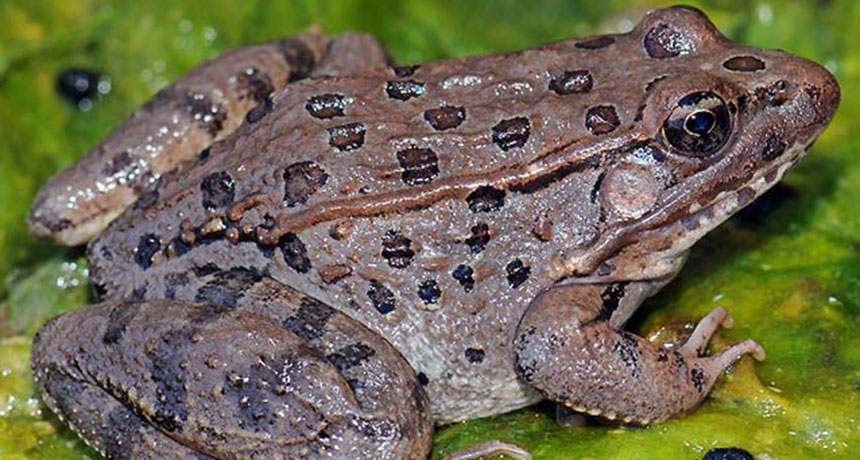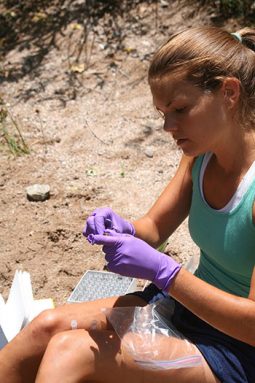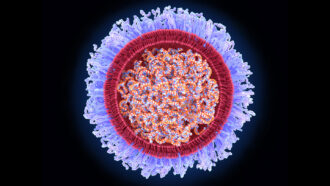Why some frogs can survive killer fungal disease
Studying how frogs evolve natural resistance to diseases could help protect their declining species

Lowland leopard frogs make their home in Arizona. Some have evolved immune defenses against a killer fungus that infects their skin.
William R. Radke/USFWS
Anna Savage hikes through a Florida swamp looking for frogs. She spots a shiny black critter hopping in the swamp grass. It’s a tiny cricket frog, no bigger than a bug. She’s hunting a killer infection — and the few frogs able to survive it.
Learning what makes these frogs special could hold a key to managing the fungal scourge.
Savage is a frog biologist at the University of Central Florida in Orlando. She catches amphibians like this tiny cricket frog to sample their skin cells. She wants to know which ones host a killer fungus. Huge numbers of frogs have been dying from a skin disease that it causes. But the fungus doesn’t kill off every infected frog. Savage is trying to figure out why. She thinks it might have something to do with the animals’ genes.
Amphibians include frogs, toads, salamanders and newts. And overall, notes Savage, “Amphibians are in trouble.” A recent study showed that populations have been shrinking for more than four in every 10 of the world’s amphibian species. Nearly one-third are threatened with extinction. And that could be bad for the environment. These animals are an important part of the food chain. They eat pesky insects, like flies and mosquitoes. Amphibians, in turn, are an important food source for many birds, reptiles and mammals.
Global loss of wetlands and other critical amphibian habitats may be causing some populations to shrink. A frog disease is causing major declines too. Its source is a single-celled fungus known as chytrid (KIH-trid). Fungal diseases are known as mycoses (My-KO-sees). So this one is called chytridiomycosis (Kih-TRID-ee-oh-my-KO-sis).
In the past few decades, this infection has been turning up all over the world. The fungus lives in wetlands and ponds. No one knows exactly where chytrid first came from. But once it infects their skin, many frogs now sicken and die.
The big question has been why some frogs have been spared. Savage now thinks she has an answer: their immune system.
Helpful mutations guard some frogs
The immune system is the body’s natural defense system against sickness and injury. Savage has been studying how this system differs in frogs that chytrid kills and those that survive. This work started a few years back while she was a PhD student at Cornell University in Ithaca, N.Y. Her first clues came from a group of lowland leopard frogs that she studied in Arizona. The fungus had infected these animals.

Genes mutate, or change, all of the time. These can lead to variations in immune system genes. The type of changes that helped leopard frogs survive the fungus were becoming more common in some populations, Savage discovered.
She and Kelly R. Zamudio of Cornell University have just shared these new data. They appear in the March 23 in Proceedings of the Royal Society B.
Frogs with genes that allow them to survive the disease will pass those genes on to their offspring, Savage explains. These offspring will also survive the fungus. Eventually, more and more frogs will be the survivors with those genes. This process of genetic change within a population is called natural selection. It’s a driving factor in the evolution of species.
The evolution of major changes within species can take thousands or even millions of years. But when there’s a very strong selective pressure, like the chytrid disease, a species may not have the luxury of millions of years. Frog species that don’t have the right genes or can’t adapt will get wiped out — immediately.
Savage’s research now shows that in some groups of Arizona leopard frogs, the immune system has evolved fast — over a few decades — to deal with the killer fungus. Similar quick-change evolution has been seen in other species that also faced dire threats to their survival.
The findings are important because they show “that in a relatively short period of time, frogs in the wild that didn’t previously have immunity may be able to evolve natural defenses against chytrid,” says Jason Rohr. He’s a frog biologist at the University of South Florida in Tampa. He, too, studies the frog immune system, but was not involved with the new research.
It’s important to protect the places where frogs live, both Rohr and Savage argue. Natural selection won’t work if the population of a species already has shrunk to the point where the protective genes that allow animals to fight the disease are now gone.
Savage is now looking at Florida frogs. So far, no one has reported major frog die-offs from the chytrid fungus in that state. That doesn’t mean the disease isn’t there. Many frogs have traces of the fungus on their skin, she has found. If scientists better understand how frogs in the wild evolve natural defenses against this fungal disease, they might find ways to halt its spread, she says — and protect those frogs that don’t have immunity.







